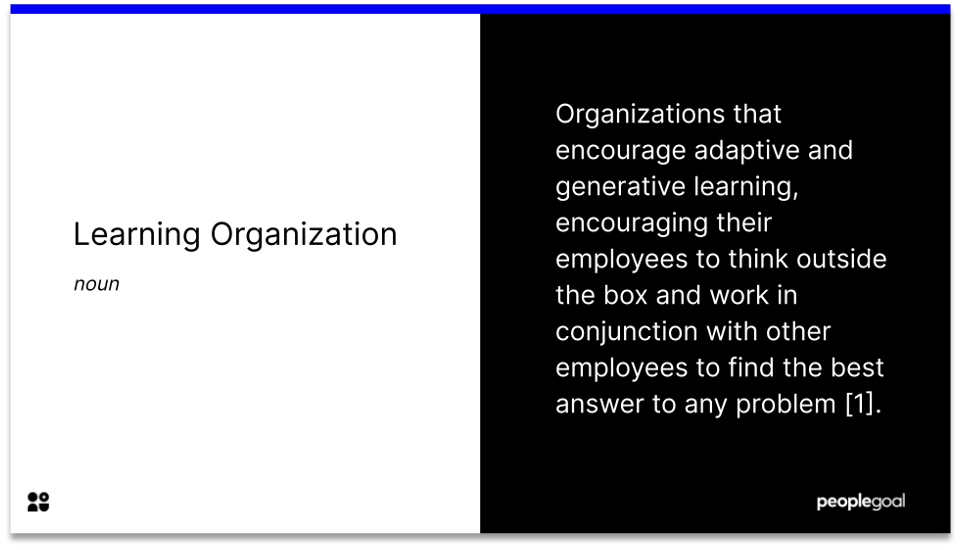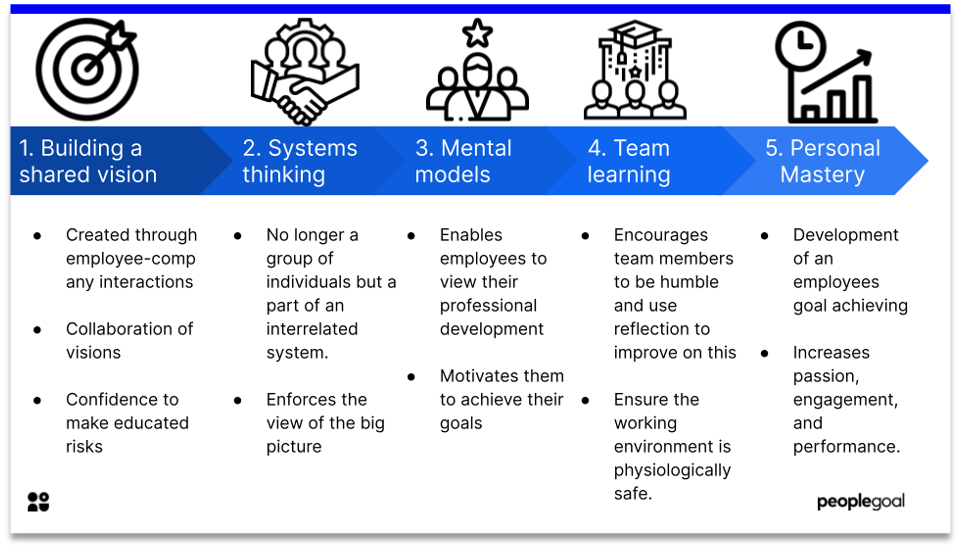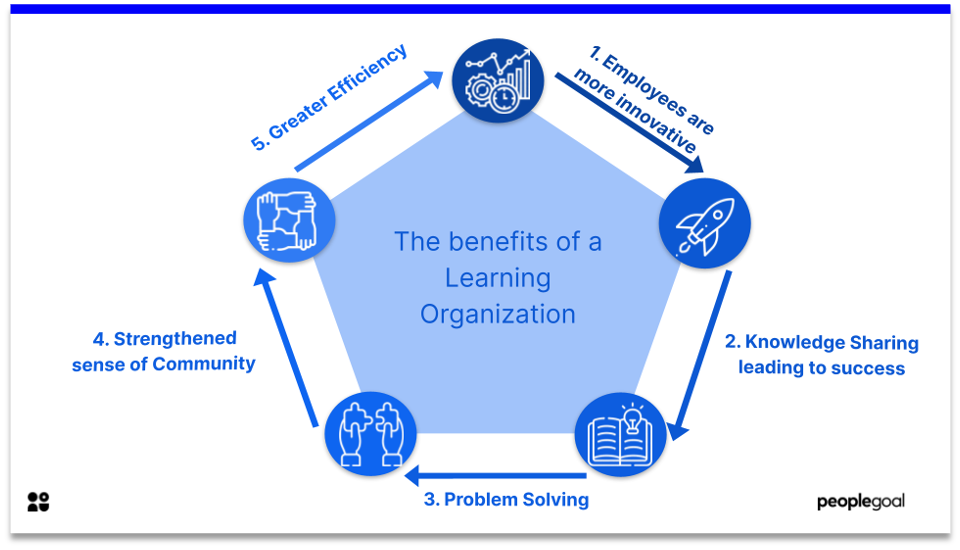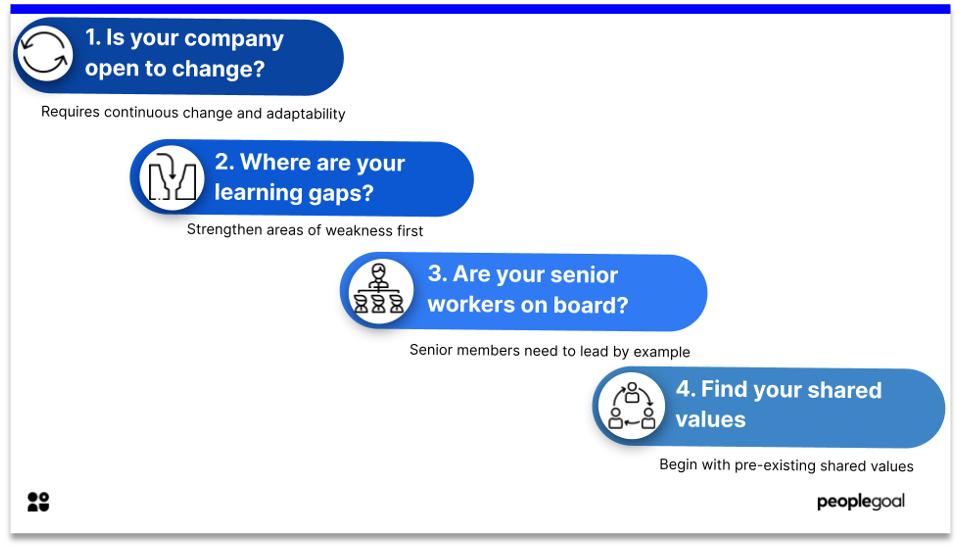Learning organizations are a company that uses the continuous learning in their team members and transformation of itself to remain competitive. This emphasized learning culture in the workplace was coined by Peter Senge and his colleagues in the early ’90s. Who had the shared vision that…
“‘learning organizations’ are those organizations where people continually expand their capacity to create the results they truly desire…and where people are continually learning to see the whole together.”
What is a Learning Organization? ℹ️
There are many different definitions and opinions on what a learning organization is. However, the definition from Senege provides a good summary. “Organizations that encourage adaptive and generative learning, encouraging their employees to think outside the box and work in conjunction with other employees to find the best answer to any problem” (Senge, 1990).

Overall, a learning organization is a culture that uses a corporate framework to encourage its employees to expand their knowledge, opportunities, and skills. This innovates both themselves and the business to provide continuous improvement.
By encouraging team learning, the company enables its reinvention when the market calls for it. This reactive growth mindset is what allows these businesses to become increasingly competitive.
Examples of Learning Organizations 🌎
Most organizations facilitate the learning process in their business. However, there are some that do this extremely well by facilitating organizational learning. Some long term learning companies are:
- General Electric: Its Crotonville learning center drives continuous learning by managers and other leaders. Havard Business gave a glowing review to their four-day program Leadership, Innovation, and Growth (LIG).
- Pizza Hut: It constantly invents and implements new technology and by recognizing the lifetime value of its customers. Read more about Pizza Hut as a learning organization on QSR’s article.
- Johnson & Johnson: Driven by its famous aims, it constantly improves products and invents new ones. This is always with the user at the center of its focus. Forbes, however, identified J&J’s one mistake which is slow adaptability.
Senges Five Disciplines of Learning Organizations 🏰
These summarise Senge’s opinions on decentralized leadership, which is the idea that all employees can work towards a common goal. It also incorporates powerful management and the learning organization philosophy.

1. Building a Shared vision
This vision should be created through interactions with the employees and the company. This can be a personal vision from a leader and through collaboration, it is incorporated into a shared one throughout the company. This leads to employees who complete tasks because they feel passionately about their [shared vision]((https://www.peoplegoal.com/blog/self-management). This lead to a positivly changed relationship within the company.
This new environment enables employees to have the confidence to take educated risks for the company. This is due to a better understanding of the final goals.
2. Systems Thinking
This follows the idea that instead of being a group of individuals, your employees are a part of an interrelated system. Therefore, preventing employees from focusing on individual issues but on the entire system at hand. This helps employees see the bigger picture and stay focused on the key company issues.
3. Mental Models
Through mental models, the employees must visualize where they would like to develop further. This prevents their deeply ingrained assumptions from affecting their decisions and interactions by helping them see the truth. This motivates them to be independent in their actions.
4. Team Learning
This requires team members to be humble. A way this is done is by using time for reflection to indicate where they need to improve on in taking other team members’ views into account. This helps with efficient knowledge sharing and can be where some of the best learning occurs.
The working environment should ensure physiological safety, where mistakes are forgiven quickly and constructive feedback is the only response. As well as teams working collaboratively in sharing ideas to help solve problems both personally and company-wide as a team.
5. Personal Mastery
Personal mastery is the development of an employee’s ability to accomplish personal goals. This is helped through maintaining an environment where employees can develop their own sense of vision that aligns with the companies.
This helps increase the level of passion workers have for their jobs increasing both engagement and performance.
Read our blog on an employee engagement survey. To see how you can easily track engagement in an easy-to-follow automated process.
The benefits of a Learning Organization ✅
This encouraging learning environment has many benefits such as:

1. Employees are more innovative
By investing your companies resources into your employees you are providing them with the best tools for their jobs. This leads to employees who are more confident and innovative in making decisions. Therefore, leading to a company with a better workforce where new ideas are encouraged. This leads to more creative concepts which leads to increased profitability in the company.
2. Knowledge Sharing leading to success
Due to your employees have the same shared goal there are now many more people actively contributing to it. This increases its probability of being met. Due to improved teamwork, these goals are usually attained through more informed decision-making.
This is due to multiple people’s opinions and knowledge is in collaboration. By ensuring all employees are on the same understanding of the goals and their role in accordance with them. This allows the company to make critical improvements.
3. Problem Solving
Learning organizations create an environment in which employees feel encouraged to take risks. This acceptance of mistakes allows for more creative solutions to problems faced.
Through collectively viewing all employee’s unique perspectives on a company-wide problem, you may identify a novel solution. This may also highlight sources of problem-solving in employees who continuously find useful answers to problems faced.
4. Strengthened sense of Community
The company investing in their employee’s learning produces a strengthened sense of community. It shows employees that you are willing to invest in them. This, in turn makes employees more engaged and loyal to the company.
Other ways this can be strengthened is through acknowledgment and ensuring their feedback is taken seriously through implementation. By showing employees their input is taken seriously makes them feel a part of the company.
Find out about our 360 feedback app, making employee feedback easy and clear.
5. Greater Efficiency
Research has shown that learning organizations produce much higher levels of job satisfaction, work performance, and commitment. These higher levels of satisfaction will in turn lead to a lower employee turnover. Therefore saving your company money from recruitment and training new employees.
It will also increase efficiency, as relationships in teams will be able to build properly. Therefore, becoming integral parts of the company. The encouraged collaborative mindset will transform teams into perceptive and efficient working units. Solving smaller problems before they are become out of hand.
How to Become a Learning Organization 🏁
Thinking of building a learning organization? Here is a checklist you need to review before you begin that process:

1. Is your company open to change?
Learning organizations require continuous updating and adaptability to maintain a strong learning culture.
2. Where are your learning gaps?
Identify these areas of weakness and implement them first to experience the most benefit from becoming a learning organization.
3. Are your senior workers on board?
This is a whole company process needing full support from the top. These individuals will be leading in making company-wide goals for all employees to follow. They can also set strong examples by following the 5 disciplines of being a learning organization closely.
4. Find your shared values
Start with a company-wide survey to find any pre-existing shared values or goals around company culture. These will be the easiest to implement in your new learning organization.
At People Goal, we use our company culture survey to assess company culture with 12 directed and easy-to-digest questions. A really strong feature is that these can be submitted anonymously. This allows you to truly get to grips with your employee’s true beliefs.
Learning Organizations: A long term solution ⌛
While some of the top companies are guiding lights in how well learning organizations work in revolutionizing their company’s. This is a long-term solution with the process of learning itself being a lengthy process. As well as positive changes from becoming a learning organization not always being immediate.
However, companies who adopt this method of work regularly surpass the 40 – 50 year average life span. Making becoming a learning organization worth the risk.
references
[1] Senge, Peter. 1990. The Fifth Discipline: Τhe Art and Practice of the Learning Organization. New York: Doubleday
Ready to 3x Your Teams' Performance?
Use the best performance management software to align goals, track progress, and boost employee engagement.


